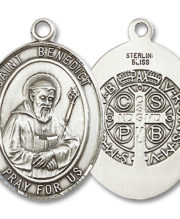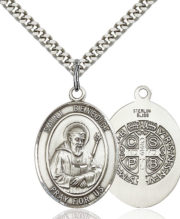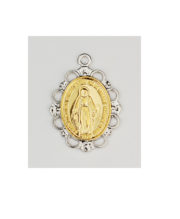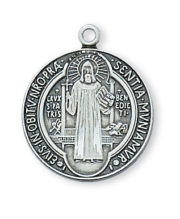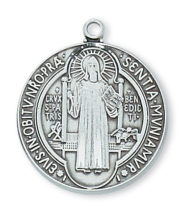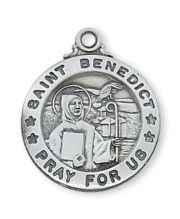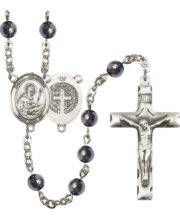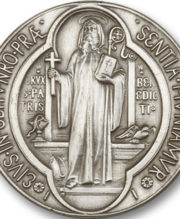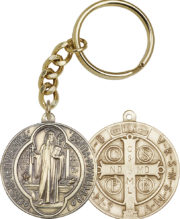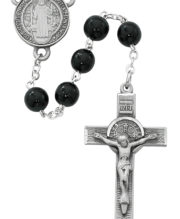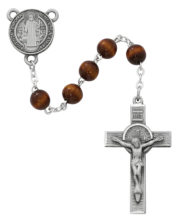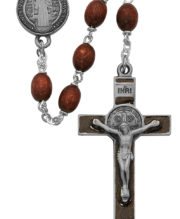Saints
St. Benedict
St. Benedict Biography
 St. Benedict of Nursia was a monastic reformer and the founder of the Benedictine Order in the 6th century. He is considered the “father of Western monasticism” and his Rule, a guide for monastic living, is still used by Benedictine communities today.
St. Benedict of Nursia was a monastic reformer and the founder of the Benedictine Order in the 6th century. He is considered the “father of Western monasticism” and his Rule, a guide for monastic living, is still used by Benedictine communities today.
St. Benedict was born in Nursia, a small town in central Italy, around 480 AD. As a young man, he was educated in Rome, but was disappointed by the moral corruption he saw there and left the city to seek a spiritual life in the countryside. He lived as a hermit for several years before attracting a small community of followers, and it was then that he began to develop his Rule, which emphasized the importance of community, manual labor, and stability.
In 529 AD, Benedict founded the monastery of Monte Cassino, which would become one of the most important monastic centers of the Middle Ages. The monastery became an influential center of learning, and Benedict’s Rule was adopted by numerous monasteries throughout Europe. His principles of monastic life, including the importance of obedience, stability, and humility, were widely accepted and were key elements in the development of Western monasticism.
Throughout his life, St. Benedict was known for his wisdom, holiness and miracles. He developed a reputation as a holy man and was sought out by people from all walks of life for guidance and counsel. He even get visited by the Pope at one point, as well as by many noblemen and religious leaders of the time, all eager to hear his teaching.
One of the most striking characteristics of St. Benedict’s Rule is the balance that it strikes between the spiritual and the practical. Benedict’s understanding of monastic life was that it was not only about contemplating God, but also about living in the real world. In his Rule, he emphasised the value of manual labour, as well as the importance of hospitality and compassion for the poor and the sick.
St. Benedict died in the year 547 AD, but his legacy lived on. His Rule became the foundation for Western monasticism, and his teachings continue to influence the monastic communities that follow it today. His order spread rapidly through the medieval West, and his influence was felt not just within the monastic community, but also in the wider church and society.
In the Catholic Church, St. Benedict is remembered as a patron saint of Europe and of monks. His feast day is celebrated on July 11th, and his symbol is the raven, which is said to have saved his life when he was a young monk. He is also known as the “father of Western monasticism” due to the great influence of his rule.
The Rule of St. Benedict is still used by Benedictine communities today, and his teachings continue to be studied and reflected upon. His impact on the Western Church and society is undeniable and even today is acknowledged by many as one of the most important figures of Western monasticism.
The Life of St. Benedict
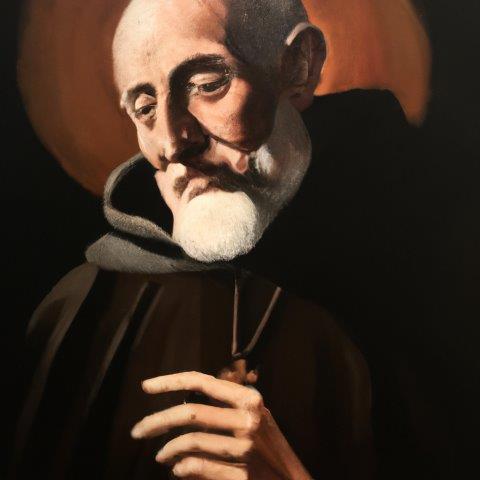 St. Benedict, the Patriarch of Western Monks, was born in 480 at Nursia, a small town in the Sabine mountains, half way between Rome and Ancona. As his father, Anicius Eupropius, was a wealthy, influential patrician, Benedict and his twin sister Scholastica enjoyed the comforts of a comfortable home under the tender care of their holy mother Abundantia. Education in Nursia seemed out of the question, so Benedict’s father decided to send him to Rome, where he could receive a training suitable to his position.
St. Benedict, the Patriarch of Western Monks, was born in 480 at Nursia, a small town in the Sabine mountains, half way between Rome and Ancona. As his father, Anicius Eupropius, was a wealthy, influential patrician, Benedict and his twin sister Scholastica enjoyed the comforts of a comfortable home under the tender care of their holy mother Abundantia. Education in Nursia seemed out of the question, so Benedict’s father decided to send him to Rome, where he could receive a training suitable to his position.
Rome was at that time a hotbed of vice. Whether Benedict was horrified at the heinousness of sin in that city, or whether he received a direct call from God to give up the world and to seek Him alone, the young Benedict resolved to leave Rome. At age 14, St. Benedict traveled forty miles until he reached Enfide at the base of the Sabine mountains. St. Benedict lived there for three months spending his days kneeling before the altar in the village church. Moved by a desire to unite closer to God, he yearned to be away from everyone, and be simply alone with God.
Journey to the Mountains
Benedict decided to continue journeying into the mountains in his search for peace. Upon reaching the ravine that connects the present Subiaco with Gender either side of which rugged, bold rocks jutted up in she precipices, he found a man wearing the robes of a monk. At first Benedict was startled, but the saint’s manner of the stranger gained his confidence, and after few words Benedict opened his heart and fully disclosed his goals and aspirations.
The holy monk felt that this was not a chance meeting, but that God had sent him as a guide to a chosen soul. He procured for Benedict the habit of a monk, and offered to show him a secret cave that would suit his purpose of seclusion with God. The cave was inaccessible from above, so Romanus arranged to provide the youth with food, to be let down in a basket by a rope, to which a bell was attached to warn of its approach Benedict was now alone with God and away from the world. He saw no one, spoke to no one. Without book, or master, or guide, he trusted entirely in God.
Alone with God in the Cave
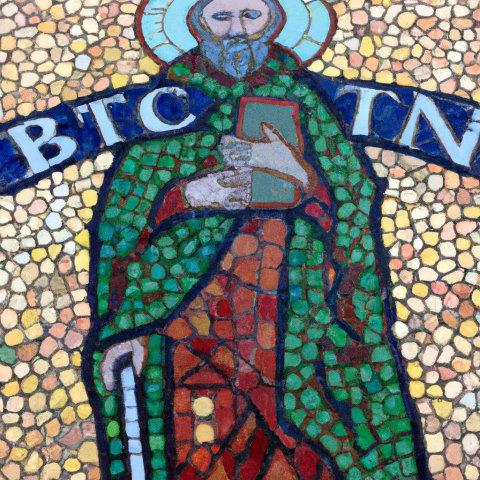 St. Benedict lived along in this cave for the next 10 to 15 years, spending his days praying and uniting close with God. One day, some peasants climbing up the mountain discovered Benedict in his cave. Benedict graciously advised them spiritually and then soon the fame of St. Benedict spread far and wide. The days of complete solitude had passed for the sanctity of St. Benedict attracted many men, who desired to join in his heavenly life and to live near him and learn from him.
St. Benedict lived along in this cave for the next 10 to 15 years, spending his days praying and uniting close with God. One day, some peasants climbing up the mountain discovered Benedict in his cave. Benedict graciously advised them spiritually and then soon the fame of St. Benedict spread far and wide. The days of complete solitude had passed for the sanctity of St. Benedict attracted many men, who desired to join in his heavenly life and to live near him and learn from him.
Establishing the Benedictine Order
He soon founded twelve monasteries in the vicinity of Subiaco. In 529, under a special guidance of God, St. Benedict left Subiaco and its twelve surrounding monasteries to travel a considerable distance to Monte Cassino, where on the site of an ancient temple of Apollo he erected a monastery, which was to become the glorious monastic center of the West. Here, at Monte Cassino, he wrote his holy Rule, the Rule of St. Benedict, a marvel of wisdom and knowledge of human nature. Besides monasteries for men, St. Benedict established several convents, where holy women followed his Rule. His sister, St. Scholastica was designated to lead one of these monasteries.
These men and women were called Benedictines. Early in 543, St. Benedict announced to his Brethren the day of his death, March 21st. On that very day, two of his monks at a distance, separated from each other, had the same vision. They saw a beautiful path, strewn with rich garments, decorated with brilliant lamps, leading from the Saint’s cell to Heaven. As they gazed at the sight an angel said to them: “This is the path by which the beloved of the Lord, Benedict, ascended up to Heaven”.
Prayers to St. Benedict
Prayer of Thanksgiving for St. Benedict
Dear God, we praise and thank You for Who You are: The Creator and Master of the Universe, and our Father who loves us and has sent Your Son Jesus to save us from our sins.
You provided your holy monk, Benedict, as a leader and master in the spiritual life for a countless number of followers. Filled as he was with the spirit of all the just, You flooded him with the splendor of Your light. In the intense radiance of this light his mind was freed of hindrance and he was able to discern how incomplete all things are here below. Because of this the entire monastic company in every part of the world sings out its joy, and the Virtues on high, with all the angels, continuously praise Your glory in song.
Stir up in your Church, O Lord, the spirit that animated our Father Benedict. Fill us again with Your Holy Spirit, in order that we may learn to love what he loved and practice what he taught. As You filled Saint Benedict with the spirit of all the righteous, grant us, your servants, who celebrate his life and all the good You have accomplished through him, his followers, and his holy Rule, to be filled with his spirit, that we may faithfully accomplish Your complete Will. We ask all this through Jesus Christ Our Lord, Who with You lives and reigns, one God, world without end. Amen.
Prayer to St. Benedict for Protection
Dear Saint Benedict, I thank God for showering you with His
grace to love Him above all else and to establish a monastic rule
that has helped so many of His children live full and holy lives.
Through the cross of Jesus Christ, I ask you to please intercede
that God might protect me, my loved ones, my home, property,
possessions, and workplace today and always by your holy blessing, that we may never be separated from Jesus, Mary, and the
company of all the blessed. Through your intercession may we
be delivered from temptation, spiritual oppression, physical ills,
and disease. Protect us from drug and alcohol abuse, impurity
and immorality, objectionable companions, and negative attitudes. In Jesus’ Name. Amen
Prayer to St. Benedict for Protection and Guidance
O holy St. Benedict, you were a shining example of faith and devotion, dedicating your life to God and serving others. I turn to you today for protection and guidance, asking for your intercession on my behalf.
Please watch over me and keep me from harm, giving me the strength and courage to face the challenges of each day. Help me to trust in God’s love and care, and to always do His will, no matter what the world may say or do.
Grant me the wisdom and understanding I need to make good decisions, and the grace to turn away from sin and turn towards righteousness. Fill my heart with love for God and for my fellow man, and help me to be a shining light of hope and compassion.
I ask this through Christ our Lord. Amen.
Prayer to St. Benedict for Healing and Strength
O holy St. Benedict, you were known for your miracle-working power and your compassion for the sick and the suffering. I come to you today, seeking your help and your healing.
Please pray for me, that I may be restored to health and strength, both in body and in spirit. Help me to trust in God’s plan for my life, and to find comfort in His loving arms, even in the midst of hardship and pain.
Grant me the courage to face each day with hope and determination, and the grace to endure all things with faith and peace. Fill my heart with your love and your spirit, and help me to always remember that God is with me, always.
I ask this through Christ our Lord. Amen.
Popular St. Benedict Medals
St. Benedict Products
St. Benedict: The Patron Saint of Europe and Protector of Monastics
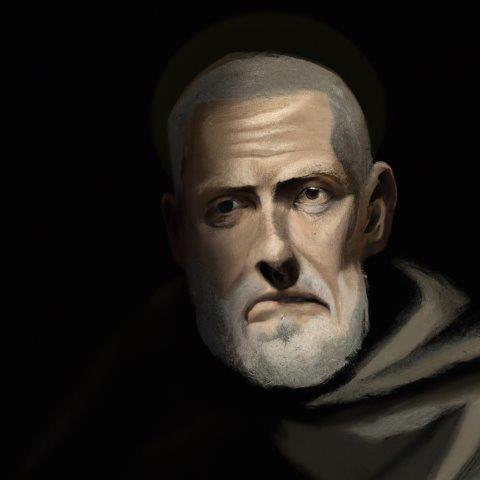 St. Benedict of Nursia, also known as the Father of Western Monasticism, was a 6th-century Italian monk who is revered as one of the most important saints in the Western Church. Benedict is the patron saint of Europe and is also considered the protector of monastics, farmers, and schoolchildren. In this blog post, we’ll explore the reasons why St. Benedict is so revered and what he represents in the eyes of the faithful.
St. Benedict of Nursia, also known as the Father of Western Monasticism, was a 6th-century Italian monk who is revered as one of the most important saints in the Western Church. Benedict is the patron saint of Europe and is also considered the protector of monastics, farmers, and schoolchildren. In this blog post, we’ll explore the reasons why St. Benedict is so revered and what he represents in the eyes of the faithful.
St. Benedict’s life and legacy
Benedict was born in Nursia, Italy, around 480 AD, and is said to have come from a wealthy family. However, as a young man, he chose to renounce his wealth and live a life of solitude and contemplation. He spent several years in a remote cave near Subiaco, where he established his first monastic community. He then went on to establish the famous Benedictine monastic order, which became a model for monastic life in the West.
Benedict is known for writing the Rule of St. Benedict, a set of guidelines for monastic life that has been followed by Benedictine monks for centuries. The Rule emphasizes the importance of balance, with equal attention given to manual labor, study, and prayer. Benedict’s teachings stress the importance of humility, obedience, and charity, and his monasteries became renowned for their hospitality and care for the sick and poor.
Why is St. Benedict the patron saint of Europe?
St. Benedict is the patron saint of Europe for several reasons. Firstly, he is credited with laying the foundation for monastic life in the West, which had a significant impact on the development of European culture and civilization. Benedict’s monasteries were centers of learning, preserving and transmitting the knowledge and wisdom of the ancient world, and providing education to those who would have otherwise gone without.
Secondly, the influence of the Benedictine order extended throughout Europe, with monasteries being established from England to Italy and beyond. These monasteries played a crucial role in the preservation of Western culture during the Dark Ages, and their influence can be seen in the fields of art, literature, and music.
Finally, Benedict himself was renowned for his humility, wisdom, and devotion, and his life and teachings continue to inspire people across Europe to this day.
Why is St. Benedict the protector of monastics and other groups?
As the founder of the Benedictine order, St. Benedict is considered the patron of monastics, who follow his teachings and live according to his Rule. Benedictine monastics live a life of poverty, chastity, and obedience, and they are known for their hospitality and care for the sick and poor.
In addition to monastics, St. Benedict is also the patron saint of farmers, as he is believed to protect crops and livestock. This stems from the fact that the Benedictine order placed great emphasis on manual labor and agriculture, and many of their monasteries had large farms that provided food and resources for the surrounding community.
Finally, St. Benedict is also the patron of schoolchildren, as he is credited with establishing the first schools in the Western world. Benedict’s monasteries provided education to those who would have otherwise gone without, and his Rule emphasized the importance of study and learning.
St. Benedict of Nursia is a towering figure in Western history, and his influence extends far beyond the monastic world. As the patron saint of Europe, he is revered for his contributions to European culture and civilization, and as the protector of monastics, farmers, and school
Reflection on the feast day of St. Benedict
The feast day of St. Benedict is celebrated on July 11th.
St. Benedict is a powerful figure in the history of Christianity, known for his wisdom and holiness. His Rule, which outlines the principles of monastic life, has been a guiding light for monastics for centuries.
One of the key principles of St. Benedict’s Rule is the idea of “”ora et labora”” or “”pray and work.”” This principle reminds us that our daily lives should be a balance of both spiritual and physical pursuits.
Another important principle of St. Benedict’s Rule is humility. St. Benedict teaches that humility is essential for true spiritual growth and that we should always strive to put others before ourselves.
St. Benedict’s life and teachings can serve as an inspiration for all of us, reminding us that true holiness is not about grandiose accomplishments or fame, but about living a simple and humble life, focused on God and serving others.
As we celebrate the feast day of St. Benedict, let us take inspiration from his life and teachings and strive to live a balanced and humble life, always putting God and others before ourselves.
Discover biographies, prayers, and reflections for more than 400 Catholic Saints
Saints Similar to St. Benedict
You may also be interested in reading the Biography of St. Scholastica. St. Benedict and St. Scholastica were siblings and saints known for their establishment of the Benedictine monastic tradition. St. Benedict is considered the founder of Western monasticism, and his sister St. Scholastica was an abbess. They are celebrated for their holiness and dedication to the monastic way of life. Next up: Biography of St. Benjamin
Also check out our handmade St. Benedict Medal and St. Benedict Rosary and St. Benedict Rosary Bracelet.

